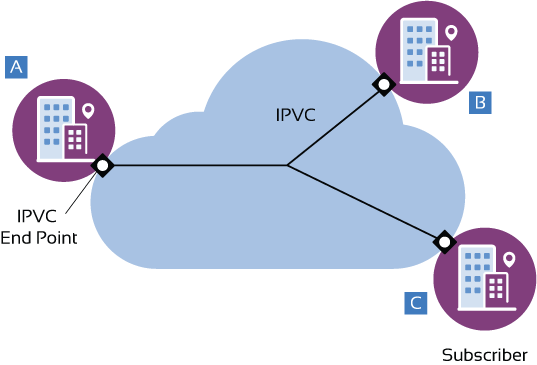Why standardize IP services? Automation. Once an IP service needs to go off-net, you enter the complex and time-consuming world of bilateral agreements between service providers. With standard terminology and attributes, the conversation not only becomes easier but one can introduce standard APIs and dramatically accelerate the responsiveness to the subscriber.
See MEF’s Technical Standards & Educational Materials for IP
The MEF IP Services and API Portfolio is a comprehensive suite of services designed to empower service providers to seamlessly offer NaaS services and capitalize on the rapidly growing Internet Access services market.
An IP Service is formed of an IP Virtual Connection (IPVC) that links together IPVC End Points at External Interfaces (EIs). EIs are what MEF calls the boundary between what is the responsibility of the service provider and what isn’t. The interface itself may connect to the end user of the network service, such as an enterprise customer, or it could be another service provider (e.g. access provider). In the case of a Subscriber IP Service, which means it’s a service for an end user, or a retail service, the IPVC End Points are specifically at User Network Interfaces (UNIs). MEF has defined Internet Access Services as its first services’ definition, and is currently working on Private IP VPN Services, to be followed by Operator Services.
Connecting subscriber locations using a MEF 3.0 IP service.

An end point of an IP virtual connection.
An IP service is formed using an IP virtual connection; a group of end points linked together.
An end user connection to the IP service. E.g. an enterprise’s branch office.
MEF 3.0 Workshop – MEF 3.0 IP Services — 2019 Nov
Product Portfolio: IP
In May 2019, MEF published its IP Service Attributes (MEF 61.1) standard that is a foundational step for defining standardized MEF 3.0 IP services that can be orchestrated across multiple service providers.
MEF 151 Cross-Connection Service Attributes — 2024 Apr
Product Portfolio: IP
Service Providers often deliver services to locations where cross-connections between the Service Provider and Subscriber, or between two Operators, are managed by a third party such as a data center provider or multi-tenant building owner.
MEF 138 Security Functions for IP Services — 2024 Jul
Product Portfolio: Cybersecurity, IP
This Standard specifies the requirements needed to add Security Functions to an IP Service.
Amends: MEF 61.1
Product Portfolio: IP
This amendment to MEF 61.1 enhances three Service Attribute areas in order to facilitate deployment of IP Services.
MEF 69.1 Subscriber IP Service Definitions — 2022 Feb
Product Portfolio: IP
This standard defines Internet Protocol (IP) Services by imposing constraints on certain MEF 61.1 Service Attributes and parameters.
MEF 61.1 IP Service Attributes — 2019 May
Amends: MEF 61
Amendments: MEF 61.1.1
Product Portfolio: IP
This document specifies the Service Attributes that need to be agreed between a Service Provider and a Subscriber for IP Services, including IP VPNs, cloud access and Internet access. It further specifies the Service Attributes that need to be agreed between a Service Provider and an Operator when part of an end-to-end IP Service needs to be implemented by a partner Operator.
I want to investigate further. See all IP resources:
Most managed IP services provided today use non-standard methods and are typically vendor and OS version specific. These bespoke methods become challenging when services need to be delivered across multiple platforms operated by two or more service providers. The result is a proliferation of manual processes or partner-specific, bilateral agreements, automation and API development. Ultimately the subscriber, that is, the enterprise suffers and growth is inhibited. MEF 3.0 IP is your standard for success.
Create new markets by introducing, guiding, and influencing standards. Actively participating in MEF work gives you the opportunity to lead initiatives that influence the industry. Our current IP projects are available in the MEF 3.0 IP Service Hub on the MEF Members’ Wiki.
All employees of active MEF-member companies are authorized to access MEF Members’ Wiki. Don’t have a login? Register. Not a member? Join MEF. Not sure? Contact Us.
Go to the Member Wiki